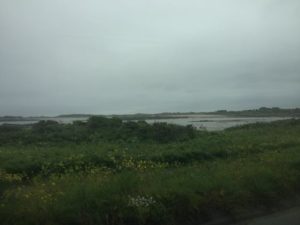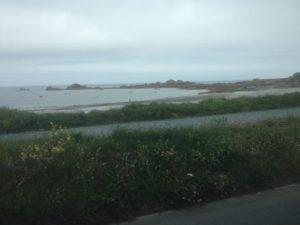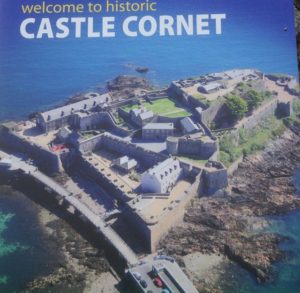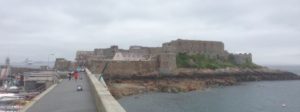We tendered into Guernsey, arriving by 8:30, before anything was open, so we took a 1.5 hr local bus around the island for 1 pound.
The oldest man-made structure in Europe is said to be the 5,000 year-old dolmen, Le Dehus, with a chamber that has a stone with a figure carved on it. Guernsey is a beautiful island with a rocky coast dotted with lots of white sand beaches and fortifications, many of them from WWII when the Germans fortified the island. The tides rise 30-40 feet, rising over the sea wall in St. Peter’s Port a couple of times a year when the moon and tides are right, more evidence of sea-level rise.
When we got back to St. Peter’s Port, we went up to Hautville House, Victor Hugo’s home in exile during the reign of Napoleon III. Although we didn’t have a reservation for a tour (required), we were lucky enough to get on a tour when two people didn’t show up for their appointment. Hugo was devoted to freedom and the Republic and went into exile the day after Napoleon declared himself emperor.
The house is a surprise, ornately decorated by Hugo and filled with pieces he designed.
He collected antique chests and disassembled them to create wall and ceiling panels as well as ornate mantles. The walls are covered with tapestries and dark panels.
The salons were intended for entertaining guests and performing plays which were performed in blue salon while guests watched from the red room.
The rooms become lighter as you rise through the floors of the house, ending with the attic to which he added a greenhouse roof. He wrote standing in this room where on clear days, he could see France.
His heirs donated the house to the city of Paris, which runs it as a museum.
The garden behind the house is lovely and has a view of the harbor.
Next we visited Cornet Castle, originally an island guarding the port, which has been used as a trade route since Roman times.
The first castle was built by the English in the 13th century to guard St. Peter’s Port harbor and has been expanded ever since. It was attacked by the French during the Hundred Years War and changed hands four tomes. During the English Civil War it was the last Royalist stronghold to surrender. When lighting struck the magazine in 1672, a huge explosion destroyed the Medieval section of the fort.
British soldiers were garrisoned her until 1940 when German forces occupied it until 1945. The castle is an immense affair that today it housed five museums and numerous small gardens. The Guernsey Literary and Potato Peel Pie Society is an epistolary novel that tells the story of the island’s inhabitants under German occupation.
There are numerous cliff walks from St. Peter’s Port. We started towards Fermain Bay and got far enough to have some views before turning back to town and our tender back to the boat













